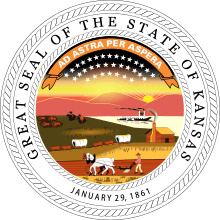
2010 election results by district
The 2010 congressional elections in Kansas were held on November 2, 2010, and determined who would represent the state of Kansas in the United States House of Representatives. Kansas has four seats in the House, apportioned according to the 2000 United States Census. Representatives are elected for two-year terms; the elected served in the 112th Congress from January 3, 2011 until January 3, 2013.
Overview
| United States House of Representatives elections in Kansas, 2010[1] |
| Party |
Votes |
Percentage |
Seats |
+/– |
|
Republican |
528,136 |
63.21% |
4 |
+1 |
|
Democratic |
274,992 |
32.91% |
0 |
-1 |
|
Libertarian |
27,360 |
3.28% |
0 |
— |
|
Reform Party |
5,041 |
0.60% |
0 |
— |
| Totals |
835,529 |
100.00% |
4 |
— |
|
District 1
When incumbent Republican Congressman Jerry Moran opted to run for Senate instead of seeking an eighth term in Congress, creating an open seat. Republican State Senator Tim Huelskamp won in a crowded Republican primary that included Jim Barnett, a fellow State Senator and the 2006 Republican nominee for Governor; Rob Wasinger, the former Chief of Staff to retiring Senator Sam Brownback; Sue Boldra, a college instructor; Tracey Mann, a real estate agent; and Monte Shadwick, the former Mayor of Salina. Huelskamp faced Alan Jilka, the Democratic nominee and another former Mayor of Salina and Jack Warner, the Libertarian candidate. As was expected in this solidly conservative[2] district that encompasses almost two-thirds of the state, Huelskamp overwhelmingly defeated Jilka and Warner and won his first term to Congress.
Polling
| Poll Source |
Dates Administered |
Tim Huelskamp (R) |
Alan Jilka (D) |
Jack Warner (L) |
Undecided |
| Survey USA |
October 5–6, 2010 |
63% |
26% |
5% |
6% |
| SurveyUSA |
August 5–8, 2010 |
65% |
23% |
7% |
5% |
Results
District 2
Freshman incumbent Republican Congresswoman Lynn Jenkins, who was initially sent to Congress after defeating previous Congresswoman Nancy Boyda in 2008, was the only member of the Kansas congressional delegation to seek re-election this cycle. This conservative[2] district that consists of most of eastern Kansas normally elects Republicans by large margins,[3] so Congresswoman Jenkins was in no real danger of losing her seat to the Democratic nominee, community organizer Cheryl Hudspeth. Though Democrats hoped to make hay out of Jenkins’ claim that Republicans needed a "great white hope" to challenge President Obama,[4] Jenkins was not vulnerable in the slightest and was overwhelmingly elected to her second term.
Results
District 3
This conservative-leaning[2] district, which is based in the Kansas City metropolitan area and the college town of Lawrence, has been represented by Democratic Congressman Dennis Moore since he was first elected in 1998. This year, however, Moore declined to seek a seventh term to Congress, calling for a "new generation of leadership."[5] On the Republican side, State Representative Kevin Yoder emerged from a crowded primary and became the Republican nominee, while Stephene Moore, a nurse and the wife of the retiring Congressman, won the Democratic nomination. Though the race was marked by sharp disagreement between Yoder and Moore,[6] it was not a close election and Yoder was sent to Congress with a whopping twenty-point margin of victory.
Results
District 4
Based around metro Wichita and rural counties in the south-central region of Kansas, this conservative[2] district has been represented by Republican Congressman Todd Tiahrt since he was first elected in the Republican Revolution of 1994. This year, though, Congressman Tiahrt declined to seek a ninth term in favor of running for Senate. Businessman Mike Pompeo edged out several rivals, including State Senator Jean Schodorf in the Republican primary, while State Representative Raj Goyle, who raised eyebrows when he was elected to represent a conservative area in the Kansas House of Representatives became the Democratic nominee. The general election was contentious, and sparks flew when the Pompeo campaign posted a link to a controversial blog that attacked Goyle’s religion and ethnic heritage that referred to him as "just another 'turban topper' we don’t need in Congress or any political office that deals with the U.S. Constitution, Christianity, and the United States of America!"[7] The Goyle camp attacked Pompeo for what they called "bigoted attacks" when the Republican candidate sponsored billboards that said "Vote American, [v]ote Pompeo" and "True Americans vote for Pompeo."[8] Pompeo denied the charges, and easily defeated Goyle in the general election.
Polling
| Poll Source |
Dates Administered |
Mike Pompeo (R) |
Raj Goyle (D) |
David Moffett/Shawn Smith* (L) |
Undecided |
| Survey USA |
October 25–28, 2010 |
54% |
38% |
2%* |
2% |
| Cole Hargrave |
October 10–11, 2010 |
48% |
31% |
- |
- |
| Survey USA |
October 6–7, 2010 |
53% |
40% |
2%* |
3% |
| Survey USA |
September 14–15, 2010 |
50% |
40% |
3% |
4% |
| Gerstein Agne |
September 8–9, 2010 |
46% |
46% |
- |
- |
| Gerstein Agne |
August 10–12, 2010 |
50% |
47% |
- |
- |
| Survey USA |
August 9–11, 2010 |
49% |
42% |
4% |
5% |
Results
References
External links





